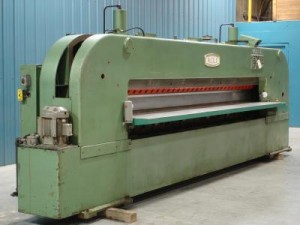 Veneer equipment is used to create veneer, thin strips/sheets of wood overlay that are applied to other wood pieces as a finishing touch. In some cases, the strips are applied to solid wood to make it appear more luxurious; while in others, they are applied to constructed wood (a.k.a. particle board) to make it appear as if it were solid wood. In either case, high-grade overlay machinery can allow woodworkers to produce products that sell for significantly more than they would without the application of the strips.
Veneer equipment is used to create veneer, thin strips/sheets of wood overlay that are applied to other wood pieces as a finishing touch. In some cases, the strips are applied to solid wood to make it appear more luxurious; while in others, they are applied to constructed wood (a.k.a. particle board) to make it appear as if it were solid wood. In either case, high-grade overlay machinery can allow woodworkers to produce products that sell for significantly more than they would without the application of the strips.
Types of Veneer Equipment
Most moderate to high production woodworking operations that use wood overlay employ at least four types of veneering machines: machines for cutting, gluing, splicing, and trimming.
1. Cutting
Three types of machines are used to cut overlay from a log: a rotary lathe, which cuts the wood in a continuous roll, producing lower quality sheets that are commonly used for plywood; a slicing machine, which raises and lowers the wood to cut pieces that appear to be sawed across growth rings, producing moderate to good quality strips; and a half-round lathe, which moves a log to expose its best sections, producing high quality strips fit for fine furniture making.
2. Gluing
Most commercial woodworking operations employ a glue spreader, a machine that applies high quality wood glue to various products prior to their being bonded with other products. In the case of veneer, glue is applied to one or more if its edges to form it into larger sheets. This is especially the case with strips produced by slicing machines and half-round lathes.
3. Splicing
A wood splicer is used to fuse smaller pieces of overlay into larger ones. After being pre-glued on one or more of their edges, the pieces are put through the splicer, emerging with a solid, heat cured bond. In addition to their splicing function, splicers also monitor overlay for defects, such as overlapping and unbonded edges.
4. Trimming
Veneer guillotines are used to either (a) trim larger pieces down to size, or (b) trim smaller pieces away from large sheets. In either case, the guillotine uses a downward cutting blade to produce a clean cut according to a woodworker’s specifications.
Is Veneering Equipment Used in Smaller Woodshops?
Veneering equipment can be used by smaller woodshops, depending on their workspace. Because most woodshops have limited workspace, industrial grade cutters are usually out of the question, although smaller cutters can be employed with great success. For lower production woodshops, glue spreaders are often a needless purchase. But splicers and guillotines are still recommended.
Is Buying Used Veneer Equipment a Sensible Option?
Buying woodworking machines used is a great cost saving option for large companies and small woodshops alike, although used domestic grade machinery and light commercial grade machinery should be avoided due to their shorter lifespan than industrial grade machinery. When purchasing used industrial machinery, observing the following four steps is key to purchasing a machine that works like new: (1) only buy from professional sellers of used woodworking machinery; (2) inspect a seller’s reputation at the Better Business Bureau (BBB); (3) only buy machines that have a impeccable maintenance record; and (4) inspect a machine firsthand before buying it.




